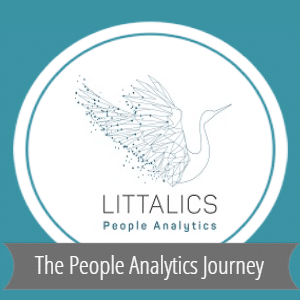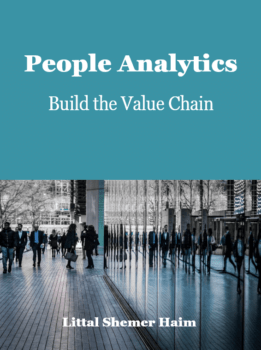People Analytics is an essential part of HR practices in many companies. However, myths and misconceptions still exist. To dismiss some myths, and to address the fears some HR practitioners may feel when it comes to People Analytics, I collaborated with my colleagues at HRweek and discussed the fundamentals of this domain of expertise. In our panel, we uncovered what is needed for setting up strong foundations for People Analytics and where to even start as an HR professional.
This panel was interesting because it included points of view of various roles: HR leader, People Analytics practitioner, scholar, consultant, and tech vendor. It was a fantastic opportunity to collaborate with Alisa Evsina, Mladen Radovic, Mirta Stantic, and Emina Hodzic. In our panel, we focused on outlining the first steps of becoming a data-driven HR team and establishing a people strategy based on inputs from People Analytics. Here are some ideas I highlighted in our talk.
What is people analytics, and when is a good time to start?
People Analytics is all about exploring, inferring, and communicating significant data patterns to initiate and support business decisions related to people in the organization.
In every organization, in any size or industry, leaders should consider leveraging workforce data, for insights that enable determining what people are needed to support the business strategy, account for costs and benefits of talent, and maximize the return on investment in the workforce.
Some motivational examples may be: Where do top employees come from? How to find more? How are top talents engaged? Why do people leave the company or stay? What return on investment is gained in training? How effective are gender and cultural diversities or global mobility? What do most successful leaders in organizations do? What qualities make up a fantastic team? As you can notice, such questions cover the whole employee lifecycle.
In a sense, People Analytics refers to exploring characteristics or behaviors and integrating them together to improve business performance. It is not about measuring the HR team’s productivity and holding it accountable.
It is also not about HR Dashboards, which are not aimed to improve business performance directly, but rather serve as a descriptive tool. Dashboards enable us to present KPIs and answer questions such as: Did we reach our goals? How far are we from achieving our goals? However, by using dashboards, we can’t answer the question: Why? For that purpose, we need People Analytics, which enables us to understand the factors that drive those KPIs presented on our dashboards. The company must be aware of its KPIs presented on the dashboard and also needs to understand how to improve those exact KPIs, in People Analytics activity.
People Analytics starts with a business question. How do we embed HR function to the business and establish partnerships with key stakeholders?
HR professionals manage various processes throughout the employee lifecycle: workforce planning, recruitment, onboarding, learning and development, feedback and evaluation, recognition and reward, promotion and internal mobility, employee experience, safety and welfare, and retirement.
These processes create aggregated workforce capabilities: engagement, culture, efficiency, leadership, innovation, and so forth. Those capabilities enable the organization to achieve its business goals: productivity, quality, and customer satisfaction, which, in turn, result in business outcomes, e.g., revenue growth and stakeholders’ return.
People Analytics means that HR focus on the use of people data derived from HR processes to impact the business. Our research approach moves from focusing on human resource processes, which we have traditionally measured, to the focus on business performance indicators on which we want to impact.
To make an impact, People Analytics initiatives start in a conversation with business leaders. It enables to prioritize projects based on real business questions. To do so, I would suggest the following: Ask about the most critical outcomes in the line of business. How is the line of business measured? Next, ask yourself how HR contributes to those business outcomes? How are HR contributions measured? Next, map the employee lifecycle, explore data collected in each stage, including systems in HR and in line of business.
Finally, you can combine all the information to define a business challenge as an analytics question: Identify a key concern, goal, or problem for the business; Create a hypothesis as to how human performance or behavior impacts upon that key concern; Define what you need to measure to test that hypothesis; and Source the data from any departments that hold it.
What is predictive analytics and how “predictive” can we actually get?
Before we discuss predictive analytics, I’d like to offer a point of view, to make sense of it. In recent years there are two significant trends regarding employee data.
First, we embrace a future perspective: We look beyond the current workforce and include in our analysis people’s data at every stage of the employment cycle: potential, candidate, current, and former employees. We try to create a lens into the future regarding likely outcomes related to business questions.
Secondly, we integrate data from various sources. Instead of isolated reporting inside the HR department, we move toward integrating various types of people-related information across the organization, in alignment with the business goals of C-level executives. We integrate various data sources from inside and outside the organization, synthesizing different information disciplines across the organization such as employee research, employee behavior, web analytics, business reporting, competitive intelligence, economic and labor market research.
Predictive analytics uses advanced mathematics to examine patterns in current and past data to predict the future. Machine learning is a computerized tool that automates predictive analytics by generating algorithms to look for patterns in data without explicitly being told what to look for.
Most of the activity in People Analytics will not leverage machine learning for predictions, because there is not enough data, or good enough data, in the organization. However, sometimes when we use it, to model a process or a decision, machine learning could have explanatory value, rather than predictive value.
It is impossible to explore here deeply the different methodologies of machine learning. However, I’d like to emphasize that it is completely different than inferential statistics that we all learned. In inferential statistics, we learn about the population from a sample, by using tools for testing hypotheses, based on some theory. In predictive analytics, we use mathematical models to predict something about an individual, based on the entire population.
How to manage sensitive questions that may have a negative impact?
HR data strategy is a funnel to which you pour business questions and extract actionable insights. In the funnel, you have data points from HR processes and platforms which you analyze and visualize. Whatever platform, analytics solution, and visualization tools you use, always start with business questions and endeavor to reach actionable insights. When you consider the business questions and any project or implementation of a tech solution always consider your stakeholders. The stakeholders of People Analytics are at all levels in the organization. C-suite executives, HR professionals, Team leaders, and employees.
When exploring sensitive topics, such as gender diversity, inclusion, and equality, based on employee data, you can actually contribute to all stakeholders. Diversity, inclusion, and equality is important topic, not only because some countries have regulations to enforce it, or because some companies want to strengthen their employer brand. It is related to better business results, as research reveals. Working in a fair company is important to everybody.
Therefore, in this topic, I suggest exploring data beyond gender distribution within units, locations, and roles, and beyond the compensation of women and man across various roles. I would use employee yearly performance reviews to explore how women are evaluated in comparison to men. Are they perceived differently in general and regarding performance, self-management, relationships, and potential leadership? I would also study the correlation between yearly reviews and promotions for the two genders, and ask: do men and women who received similar reviews get a similar promotion?







